Imagine a world where computers exist, but no one can tell them what to do. Sounds impossible, right? Yet, in the early days of computing, this was the reality. There were no applications or software, just a machine waiting for instructions.
This challenge led to creating programming languages that allow humans to communicate with computers. These languages have dramatically evolved, ranging from complex machine code to user-friendly ones like Python and JavaScript. But where did it all begin?
This article will examine the history of programming languages, from their earliest forms to the powerful tools we use today.
Read along as we uncover how programming languages transformed the world and paved the way for the digital age!
Introduction
A programming language is a set of rules and instructions that allow humans to communicate with computers. Just like we use English, Spanish, or Mandarin to talk to each other, programmers use languages like Python, Java, or C++ to give computers commands.
Computers do not understand human language but process information as a binary machine code. Writing directly in machine code would be nearly impossible for humans, so programming languages act as a bridge, translating our instructions into something computers can execute.
What is a programming language?
A programming language is a structured system of commands used to instruct computers. It translates human-readable code into machine-executable instructions.
Programming languages, from mobile applications to massive software systems, power everything in the digital world. Whether Python runs your favorite AI assistant or C++ handles high-performance gaming engines, these languages make modern technology possible.
Without programming languages, we would not have websites, apps, or operating systems that power our devices. They are the backbone of modern technology, turning human ideas into functional digital realities.
The birth of programming languages (Pre-1950s)
Before sleek laptops and smartphones, early computers were massive machines requiring intricate manual configurations to perform basic calculations. But even in those early days, brilliant minds worked on automating computing, laying the foundation for modern software systems. Let’s take a closer look.
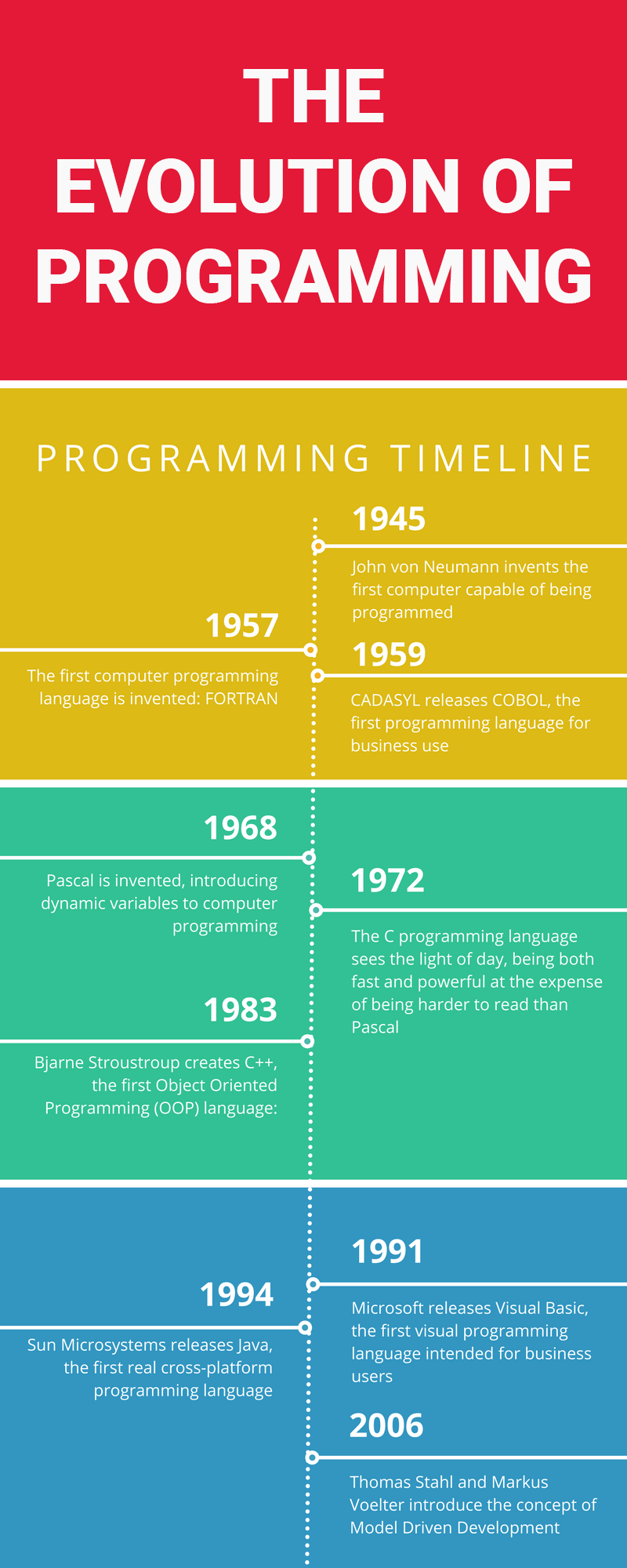
A quick overview of the evolution of programming over the years (Triggre)
Ada Lovelace: the first programmer
It all started with the first programmer - Ada Lovelace. She was a prominent figure in computer science history who saw the true potential of machines. In the mid-1800s, Lovelace worked alongside Charles Babbage on the first computer, the Analytical Engine.
While Babbage designed the machine, Lovelace recognized that it could do more than simple calculations. Hence, she theorized that it could follow a sequence of instructions, much like modern programming.
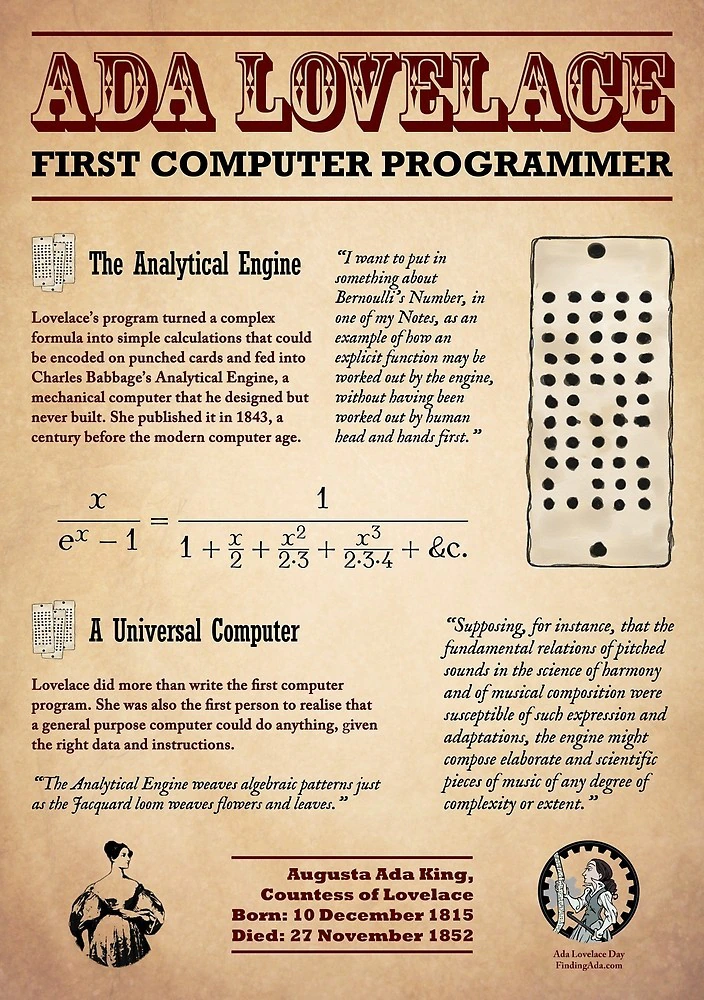
A look at Ada Lovelace’s contribution to the programming world (India Today)
Lovelace did not just predict the future; she also wrote the first algorithm for machine execution, making her the world’s first programmer. This laid the groundwork for the concept of a computer language, proving that machines could be programmed to perform tasks beyond pure arithmetic.
Early attemps at automated computing
Almost a century after Lovelace’s attempts, automated computing became a reality. In the late 19th and early 20th centuries, punch card systems, developed initially for weaving patterns in textiles, were adapted for computing. These allowed machines to store and process information without human intervention.

Punch card patterns were adapted for programming (IBM)
By the 1940s, the first language for computers emerged as a machine code. It referred to a series of binary instructions (1s and 0s) that computers could understand. While complex to write, machine code paved the way for the structured computer languages that followed.
Binary logic and konrad zuse
One of the most significant breakthroughs in automated computing came from Konrad Zuse, a German engineer and computing pioneer. In 1936, Zuse invented the Z1, one of the first programmable computers.
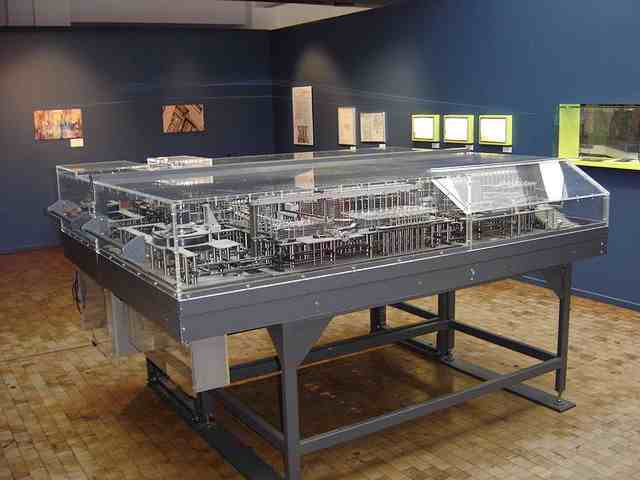
Konrad Zuse created Z1 - The First Mechanical Computer (NCLab)
He later also built the Z3 (1941), widely regarded as the first programmable, fully functional digital computer. Unlike earlier mechanical machines, Zuse’s designs introduced the concept of binary logic, a fundamental principle in modern computing.
In the 1940s, he developed the first high-level programming language, Plankalkül. Though it was not widely adopted, Plankalkül was a forerunner to later programming languages, proving that computers could be programmed at a more abstract level rather than relying solely on machine code.
These early innovations set the stage for the digital revolution, proving that computers could be more than just giant calculators. The journey from Lovelace’s algorithm to the first actual programming languages was beginning.
The rise of high-level languages (1950s–1970s)
While punch cards and early machine code were the start, programmers needed to simplify the instructions. It led to the rise of high-level programming languages, a notable shift from the low-level assembly language.
From the 1950s to the 1970s, several groundbreaking languages were invented, laying the foundation for modern software development. Despite these languages being decades old, Many are still used today in various fields. Thus, let’s explore the key languages of this era.
Fortran (1957) — The first high-level language
The first programming language designed for high-level scientific computing was Fortran (Formula Translation). Developed by John Backus and his team at IBM in 1957, it made computer programming more accessible to scientists and engineers.
It enabled programmers to write mathematical equations in a structured way, making it a game-changer for applications in physics, weather modeling, and engineering simulations. Its efficiency and numerical computing capabilities made it a staple in the scientific community.
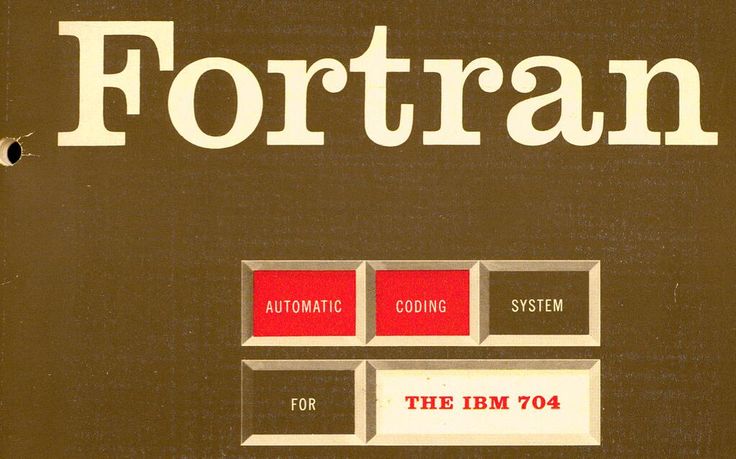
Fortran was the first high-level language developed by IBM (Pinterest)
Lisp and functional programming (1958)
A year later, John McCarthy brought Lisp (List Processing) to the market as the first programming language designed for artificial intelligence. Unlike Fortran, which focused on number crunching, Lisp introduced powerful concepts like recursion and symbolic processing, which made it ideal for AI research.
Lisp pioneered functional programming and influenced many modern languages, including Python and JavaScript. Despite being over six decades old, Lisp has remained relevant, especially in AI and machine learning research.
COBOL (1959) — The business language
While Fortran and Lisp catered to science and AI, the business world needed a programming language optimized for handling large amounts of data and financial transactions. That is where COBOL (Common Business-Oriented Language) came in. COBOL was created in 1959 by a committee known as the Conference on Data Systems Languages (CODASYL). Grace Murray Hopper was one of the key figures behind its development.
Its goal was to standardize programming for government and financial institutions. Its simple, English-like syntax made it easier for non-technical professionals to understand and use. It remains critical in banking, insurance, and legacy systems.
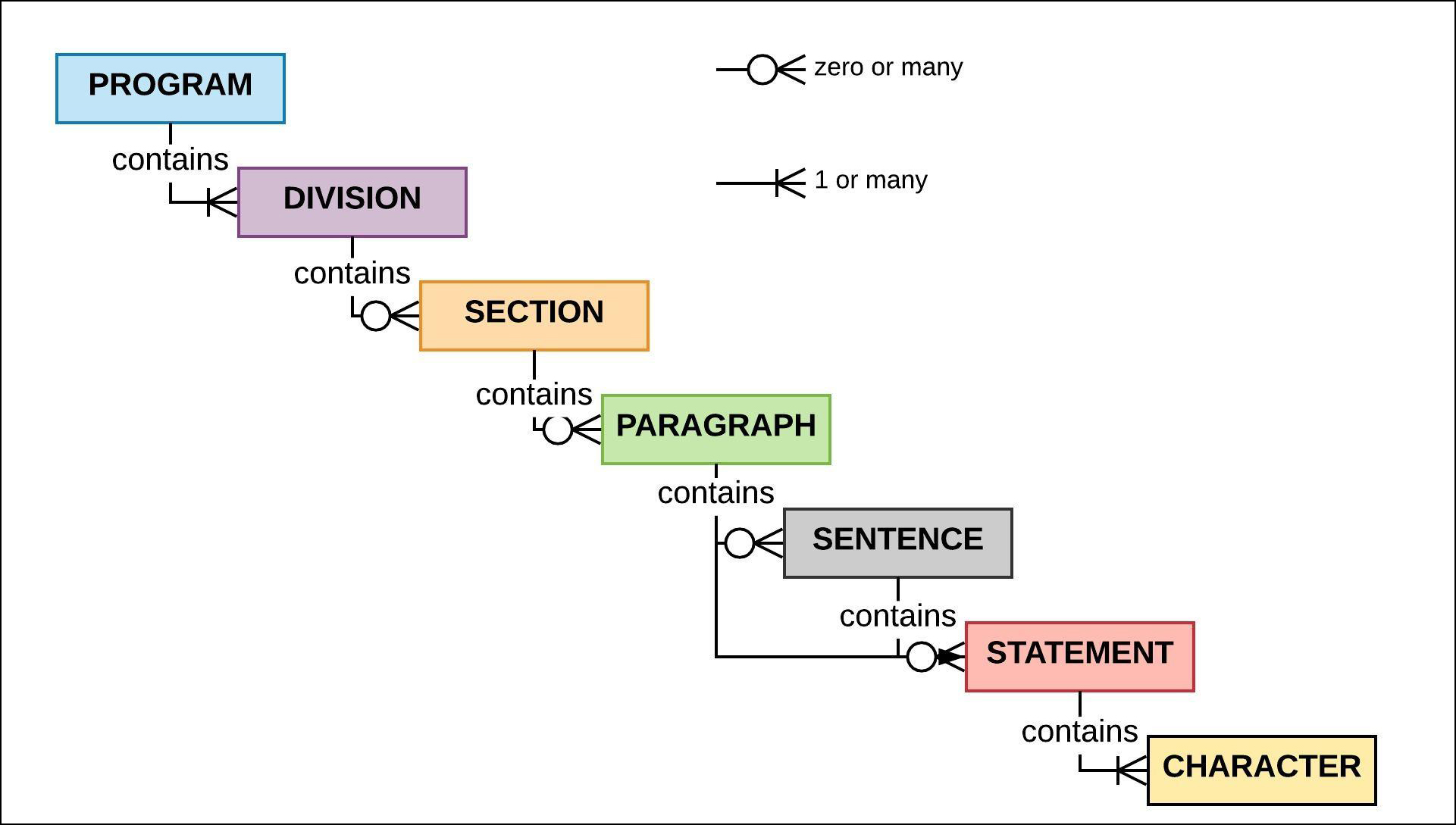
COBOL program structure overview (DevOps)
C (1972) — The universal language
C was developed by Dennis Ritchie in 1972 at Bell Labs. It provides low-level memory access, like assembly language, but with the ease and structure of high-level programming. Its most significant impact was on operating systems, particularly UNIX.
Modern languages like C++, Objective C, and Java are rooted in C. C's efficiency, speed, and portability, making it one of the most widely used programming languages in system software, embedded programming, and modern applications.
Thus, computer programming evolved from machine code and assembly language to structured, human-readable languages. Fortran, Lisp, COBOL, and C each played a crucial role in setting the stage for more advancements in the 1980s and beyond.
The era of object-oriented programming (1980s–1990s)
Over time, computers have become more powerful, and software systems have become more complex, leading to the need for better ways to manage code. This resulted in the development of Object-Oriented Programming (OOP).
This approach structured programs around "objects" rather than just functions and procedures, making designed software more reusable, scalable, and easier to maintain.
It led to creating some of the most influential high-level programming languages, still widely used today. Let’s examine the key languages that shaped this era.
Smalltalk (1980) and the irth of OOP
Before the 1980s, most programming relied on procedural logic, making complex systems challenging to scale. 1980 Smalltalk, a language developed at Xerox PARC, introduced core OOP concepts like classes, objects, and inheritance.
It was a business-oriented vision of software structure, laying the foundation for later OOP languages like C++, Java, and modern scripting languages. Though not as widely used today, Smalltalk's influence on software design is undeniable.
C++ (1985) — power and performance
Building on the success of the C language, Bjarne Stroustrup developed C++ in 1985, adding OOP features while maintaining C's efficiency and low-level control. This combination made C++ incredibly powerful for creating high-performance software with reusable components.
C++ quickly became the language for everything from game engines to financial systems. Its ability to handle large-scale applications while optimizing performance made it the go-to choice for many industries.
Python (1991) — simplicity and readability
While C++ was all about power, Python, developed by Guido van Rossum in 1991, focused on simplicity and readability. Unlike other OOP languages that could be complex and difficult to learn, Python’s clean syntax made it more beginner-friendly.
Python quickly gained popularity in science, data analysis, and web development due to its versatility and ease of use. Today, Python powers everything from AI research to automation, making it one of the most in-demand high level programming languages.
Java (1995) — "Write once, run anywhere"
In 1995, Sun Microsystems introduced Java, a game-changing programming language designed to be platform-independent. Its slogan, “Write Once, Run Anywhere,” referred to the Java Virtual Machine (JVM), which allowed its programs to run on any operating system without modification.
Java’s portability made it suitable for enterprise applications, mobile development, and large-scale systems. It became the backbone of Android apps and web-based applications, becoming one of the most influential computer programming languages ever.
| TOPIC | C++11 | Java 8 | Python 3.5 |
|---|---|---|---|
| Memory management | manual allocation manual deallocation | manual allocation automatic garbage collection | automatic allocation automatic deallocation |
| Code length | Longer lines of code as compared to Python. | About 40% more code in comparison to C++ | 3–5 times shorter than Java programs |
| Typing system | statically typed, both code and compiler | statically typed, both code and compiler | dynamically typed, Interpreter is strongly typed, language is type-free! |
| Compiling | Compiled to machine code | Compiles to byte code, then interpreted by the JVM | Interpreted by the Python interpreter |
| Execution speed | 100% | 1176% | 1800% |
| Portability | Platform dependent, must be recompiled for different platform | Platform independent, byte code generated works on every OS. | Platform independent, code is interpreted upon execution. |
| Thread support | Built-in support since C++11 | It has built-in thread support. | No multithreading! |
These developments marked the 1980s and 1990s with the revolution of high level programming with the rise of OOP. This era also paved the way for later innovations like Visual Basic, a programming language that further simplified application development.
The internet age and modern programming (2000s–Present)
The 21st century saw an explosion of digital transformation after the 1990s. Computer programming evolved to meet new demands as the internet became integral to daily life.
Web technologies, mobile apps, and artificial intelligence have pushed developers to create faster, more efficient, and scalable programming languages. With businesses relying more on online platforms, every web app development company seeks languages that can power dynamic, high-performance applications.
From powerful web applications to AI-driven innovations, modern programming languages continue to shape how we interact with technology. Let’s explore some key developments in this era in the 21st century.
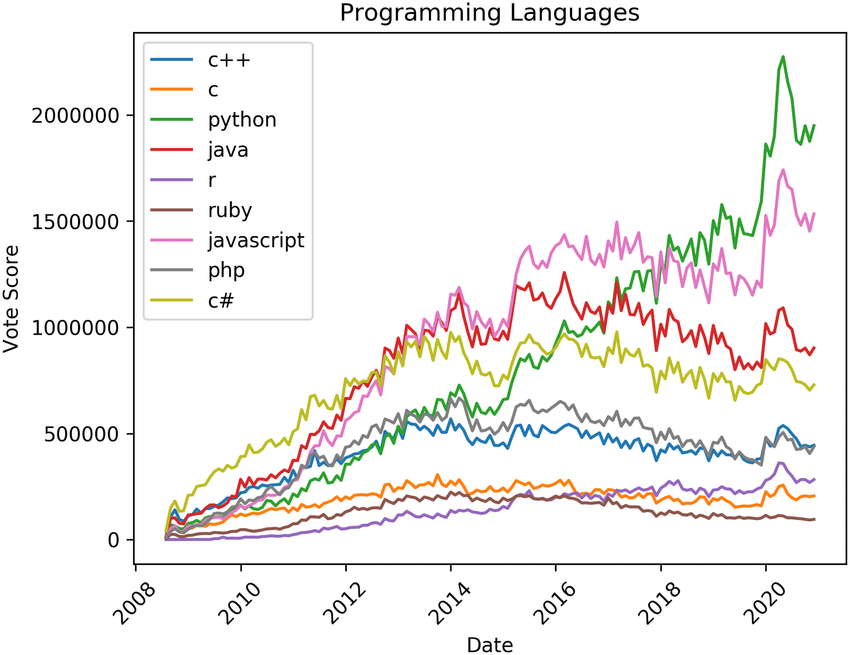
Overview of the trends in the popularity of key programming languages (ResearchGate)
JavaScript and the rise of web development
In the mid-1990s, Brendan Eich invented JavaScript, a scripting language designed to make websites more dynamic. In the 2000s, JavaScript became the backbone of web development with frameworks like React, Angular, and Vue.js.
Martin Odersky also played a crucial role in Java’s evolution, particularly in the development of Generic Java and improvements to the Java compiler. His contributions helped shape Java’s type system, making it more flexible and scalable for modern applications.
Later, he created Scala, a language that runs on the Java Virtual Machine (JVM) and combines object-oriented and functional programming principles, further influencing the world of software development.
Thus, with its many tools, JavaScript transformed how websites function, allowing interactive elements, animations, and seamless user experiences. Today, every web app development company relies on JavaScript to build modern web applications.
Swift and Kotlin — the mobile revolution
As mobile devices became more powerful, Apple and Google needed programming languages optimized for mobile development. Apple introduced Swift in 2014 to provide a safer and more efficient alternative to Objective-C for iOS applications.
Another player that came to the market was Kotlin, which Google developed. It is a modern-level programming language that improved upon Java for Android development.
Both languages made mobile development more accessible and streamlined, helping developers build high-performance apps with fewer errors and greater efficiency. Swift and Kotlin have since become the standard for iOS and Android programming, defining the modern mobile experience.
the role of AI and machine learning languages
While AI and machine learning have led to the development of intelligent systems, behind every system is a programming language that makes it all possible. Below are some specific languages that make AI models more innovative, data analysis faster, and automation more efficient.
Python: the king of AI and machine learning
With its easy-to-learn syntax and powerful libraries like TensorFlow, PyTorch, and Scikit-learn, Python has become the go-to language for AI and machine learning development.
It allows data scientists to process vast amounts of data, build deep learning models, and automate complex tasks with minimal effort. Even Bill Gates has praised Python for its simplicity and efficiency in modern computing.
R: the data science powerhouse
R is a top choice for statisticians and data analysts. This language is built for data visualization, statistical computing, and big data processing.
Researchers and data scientists use R for predictive analytics, making it a key player in AI-driven decision-making. Its flexibility and vast ecosystem of packages make it invaluable for businesses looking to gain insights from large datasets.
Julia: speed meets AI
Julia is designed for numerical computing and machine learning and offers fast execution speeds, making it ideal for large-scale AI applications. It is helpful in research and technical computing to process massive datasets quickly. While not as widely adopted as Python or R, Julia is gaining traction among AI engineers who need speed and flexibility.
Ruby: simplicity in AI development
While Ruby is often associated with web development, it has also found a place in AI and machine learning. Yukihiro Matsumoto created Ruby, focusing on developer happiness, making it an easy-to-learn language that prioritizes readability and simplicity.
Though not as dominant as Python in AI, Ruby's clean syntax and efficient frameworks, such as TensorFlow.rb, make it a viable choice for machine learning applications.
To sum up, whether Python is leading the charge, R handles big data, Julia delivers speed, or Ruby makes AI more accessible, the correct language can make all the difference in creating intelligent, data-driven solutions.
Conclusion
From Ada Lovelace’s first algorithm to today’s AI-driven innovations, programming languages have come a long way. Each era has introduced new ways to communicate with machines.
Visionaries like Murray Hopper also played a crucial role in making programming more accessible, helping bridge the gap between complex machine code and user-friendly languages. This evolution of programming is not just about writing code.
It is also about making technology more robust, accessible, and efficient. Whether you’re a beginner learning Python or an expert developing AI models, every programming language builds on the past while shaping the future. With new advancements on the horizon, programming will undoubtedly continue to evolve, unlocking new possibilities in the digital world.
Apr 8, 2025
